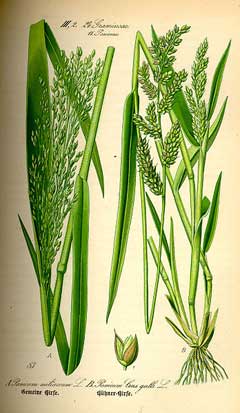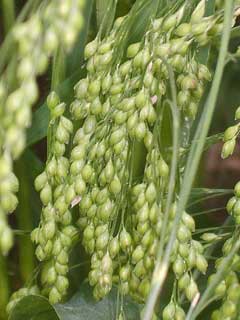 |
|
http://commons.wikimedia.org/wiki/File:Illustration_Panicum_miliaceum0.jpg |
 |
| http://commons.wikimedia.org/wiki/User:Dalgial |
Translate this page:
Summary
Physical Characteristics

 Panicum miliaceum is a ANNUAL growing to 1 m (3ft 3in) by 0.2 m (0ft 8in).
Panicum miliaceum is a ANNUAL growing to 1 m (3ft 3in) by 0.2 m (0ft 8in).
See above for USDA hardiness. It is hardy to UK zone 5. It is in flower from July to October. The species is hermaphrodite (has both male and female organs) and is pollinated by Wind.
Suitable for: light (sandy), medium (loamy) and heavy (clay) soils and prefers well-drained soil. Suitable pH: mildly acid, neutral and basic (mildly alkaline) soils. It cannot grow in the shade. It prefers dry or moist soil and can tolerate drought.
UK Hardiness Map
US Hardiness Map
Synonyms
Panicum milliaceum
Plant Habitats
Edible Uses
Edible Parts: Seed
Edible Uses:
Seed - cooked as a whole grain or ground into a powder and used as a flour for making breads, pasta and fermented foods such as 'tempeh'[2, 34, 183]. A nutty flavour, it is more easily digested than many cereals because its high alkaline content counteracts acids[183]. It is also free of gluten and so, although bread made from it does not rise, the cereal is suitable for people with coeliacs disease or other gluten intolerances[K]. The seed can also be sprouted and added to salads, soups etc[183]. The seed contains about 10% protein, 4% fat[61].
References More on Edible Uses
Medicinal Uses
Plants For A Future can not take any responsibility for any adverse effects from the use of plants. Always seek advice from a professional before using a plant medicinally.
Demulcent Poultice Refrigerant
The seed is cooling and demulcent[218]. The cooked seed is applied as a poultice for abscesses, sores etc whilst juice from chewed seeds is applied to children's sores[218]. The seed is also incinerated and mixed with oil then used as a poultice that is said to heal sores without leaving a scar[218]. A decoction of the root is used as an antidote to poisoning by Momordica spp, it is also used to treat haematuria in women and as a bath for skin eruptions[218].
References More on Medicinal Uses
The Bookshop: Edible Plant Books
Our Latest books on Perennial Plants For Food Forests and Permaculture Gardens in paperback or digital formats.

Edible Tropical Plants
Food Forest Plants for Hotter Conditions: 250+ Plants For Tropical Food Forests & Permaculture Gardens.
More

Edible Temperate Plants
Plants for Your Food Forest: 500 Plants for Temperate Food Forests & Permaculture Gardens.
More

More Books
PFAF have eight books available in paperback and digital formats. Browse the shop for more information.
Shop Now
Other Uses
Fibre Sandpaper
A starch from the seed is a substitute for corn starch (Zea mays). It is used for sizing textiles[114]. The leaves are a source of fibre used in paper making[74].
Special Uses
References More on Other Uses
Cultivation details
Requires a moderately fertile well-drained soil in full sun[200]. Succeeds in ordinary garden soil[1]. Tolerates heat and also drought when it is established[1]. European millet is frequently cultivated in warm temperate and sub-tropical zones for its edible seed, there are many named varieties[57, 183]. Cultivation in Britain is somewhat problematic, the plants require good summers to do well and a dry period in late summer is required in order to ripen and dry the seed. We have had fairly good results on our trial grounds in Cornwall by starting the seed off early in a greenhouse, though this is a fairly labour-intensive method and therefore much less efficient than growing the more traditional temperate zone cereals[K]. Yields are also considerably lower than other cereals that can be grown in this country, although the nutritional value of millets is said to be superior to wheat, oats, etc[K].
References Carbon Farming Information and Carbon Sequestration Information
Temperature Converter
Type a value in the Celsius field to convert the value to Fahrenheit:
Fahrenheit:
The PFAF Bookshop
Plants For A Future have a number of books available in paperback and digital form. Book titles include Edible Plants, Edible Perennials, Edible Trees,Edible Shrubs, Woodland Gardening, and Temperate Food Forest Plants. Our new book is Food Forest Plants For Hotter Conditions (Tropical and Sub-Tropical).
Shop Now
Plant Propagation
Seed - sow spring in a greenhouse and only just cover the seed. Germination should take place within a week. Prick out the seedlings into trays or individual pots and plant them out after the last expected frosts[200, K].
Other Names
If available other names are mentioned here
Broom Millet, , Baragu, Broomcorn millet, Cheen, Cheena, Chena, Chenaa, Chino, Dokhan, Echte Hirse, European millet, Ji, Kadukanni, Ke, Kibi, Meneri, Miglio, Mijo, Mil, Milho miudo, Milium, Millet Panic, Nage, Panivaragu, Shu, Varagalu, Vari, Variga, Varo, brown millet, chinese millet, common millet, common millet, proso millet|wal meneri, french millet, gijang, hirs, little millet, millet, panic faux-millet, panicum millet, proso millet, red millet, white french millet, white millet.
Native Range
TEMPERATE ASIA: Iran (east), Russian Federation-Western Siberia (Western Siberia (south)), Russian Federation-Eastern Siberia (Eastern Siberia (south)), Kazakhstan (east), Kyrgyzstan, Tajikistan, Mongolia, China
Weed Potential
Right plant wrong place. We are currently updating this section.
Please note that a plant may be invasive in one area but may not in your area so it's worth checking.
Conservation Status
IUCN Red List of Threatened Plants Status : This taxon has not yet been assessed

Growth: S = slow M = medium F = fast. Soil: L = light (sandy) M = medium H = heavy (clay). pH: A = acid N = neutral B = basic (alkaline). Shade: F = full shade S = semi-shade N = no shade. Moisture: D = dry M = Moist We = wet Wa = water.
Now available:
Food Forest Plants for Mediterranean Conditions
350+ Perennial Plants For Mediterranean and Drier Food Forests and Permaculture Gardens.
[Paperback and eBook]
This is the third in Plants For A Future's series of plant guides for food forests tailored to
specific climate zones. Following volumes on temperate and tropical ecosystems, this book focuses
on species suited to Mediterranean conditions—regions with hot, dry summers and cool, wet winters,
often facing the added challenge of climate change.
Read More
Expert comment
Author
L.
Botanical References
17200
Links / References
For a list of references used on this page please go here
A special thanks to Ken Fern for some of the information used on this page.
Readers comment
| Add a comment |
|
If you have important information about this plant that may help other users please add a comment or link below. Only comments or links that are felt to be directly relevant to a plant will be included. If you think a comment/link or information contained on this page is inaccurate or misleading we would welcome your feedback at [email protected]. If you have questions about a plant please use the Forum on this website as we do not have the resources to answer questions ourselves.
* Please note: the comments by website users are not necessarily those held by PFAF and may give misleading or inaccurate information.
To leave a comment please Register or login here All comments need to be approved so will not appear immediately.
|
Subject : Panicum miliaceum
|
|
|
|